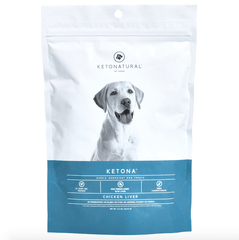Save Money, Save Your Dog.
Join Our Email List For Discounted Pricing and a Free Guide to the Science of Keto Dog Food.
Do Raw Ingredient Pet Foods Increase the Risk of Infection with Food-Borne Pathogens and Related Illnesses in Either Pets or Owners?
Original White Paper can be viewed here
ABSTRACT
Critics of raw animal ingredient pet diets frequently cite the increased risk of infection with food-borne pathogens as a cost associated with such diets. In this white paper we briefly examine the evidence surrounding this issue, with regard to both pets and their owners. We conclude that raw ingredient diets carry food borne pathogens far more often than processed pet food products, that those pathogens often infect pets fed such diets, and that the pathogens can be (and with some regularity are) transmitted to pet owners. We also note, however, that dogs do not tend to display symptoms of infection with Salmonella bacteria, one of the most common pathogens associated with pet food products.
EVIDENCE REVIEW
The evidence clearly shows that feeding raw animal products to dogs and cats increases the risk that the animals will become carriers for food-borne pathogens, particularly one or more strains of Salmonella. As a result, the prevalence of Salmonella in the feces of dogs and cats fed raw animal product diets has usually been found to be dramatically higher (in some cases by as much as a factor of ten) than in animals fed processed diets, with studies typically placing the incidence of positive cultures in the feces of raw-fed animals at 30% or more.
The evidence also clearly shows that pathogens can be (and with some regularity are) transmitted from pets (or pet food products) to pet owners. Numerous pet food-related Salmonella outbreaks have been documented in the United States and Canada over the past 20 years. Salmonella infections associated with contaminated dry pet foods, pig ears, and other meat-based treats have been reported in the literature. In these cases, infection was most common among young children (where the risk of infection in households that had recently purchased contaminated food was as much as seven times as high as in control households), as well as seniors and immunocompromised individuals. In these individuals and more broadly, hand washing has been shown to reduce the risk of infections markedly, with one research team (Stull 2013) going so far as to describe hand hygiene as playing a “critical role” in reducing the risk of zoonotic infections.
It is important to note, however, that dogs tend not to display overt symptoms of Salmonella infection. The evidence seems to suggest that at least half of all cases are subclinical, and in cases where symptoms are displayed they tend to be mild (moderate diarrhea being the most common symptom).
OVERALL SUPPORT FOR PRIMARY THESIS
8/10: Clear and consistent empirical evidence, subject to meaningful risk reduction with appropriate safety measures.
REFERENCES
[1] Behravesh et al. 2010. “Human Salmonella Infections Linked to Contaminated Dry Dog and Cat Food, 2006-2008.” Pediatrics. 126(3).
[2] Burnie et al. 1983. “The Excretion of Compylobacter, Salmonellae and Giardia Lamblia in the Faeces of Stray Dogs.” Veterinary Research Communications. 6:133-38.
[3] Clark et al. 2001. “Characterization of Salmonella Associated With Pig Ear Dog Treats in Canada.” Canadian Journal of Clinical Microbiology. 39(11):3962-68.
[4] Joffe et al. 2002. “Preliminary Assessment of the Risk of Salmonella Infection in Dogs Fed Raw Chicen Diets.” Canadian Veterinary Journal. 43(6):441-42.
[5] KuKanich. 2011. “Update on Salmonella spp. Contamination of Pet Food, Treats, and Nutritional Products and Safe Feeding Recommendations.” Journal of the American Veterinary Medical Association. 238(11):1430-34.
[6] Leonard et al. 2011. “Evaluation of Pet-Related Management Factors and the Risk of Salmonella spp. Carriage in Pet Dogs From Volunteer Households in Ontario (2005-2006).” Zoonoses and Public Health. 58(2):140-49.
[7] Lenz et al. 2009. “Perceptions, Practices, and Consequences Associated With Foodborne Pathogens and the Feeding of Raw Meat to Dogs.” Canadian Veterinary Journal. 50(6):637-43.
[8] Schlesinger et al. 2011. “Raw Food Diets in Companion Animals: A Critical Review.” Canadian Veterinary Journal. 52(1):50-54.
[9] Selmi et al. 2011. “Contaminated Commercial Dehydrated Food as a Source of Multiple Salmonella Serotypes Outbreak in a Municipal Kennel in Tuscany.” Veterinaria Italiana. 47(2):183-90. Do Raw Ingredient Pet Foods Increase the Risk of Infection with Food-Borne Pathogens and Related Illnesses in Either Pets or Owners? Evidence Review Scientific Advisory Committee, KetoNatural Pet Foods COPYRIGHT 2017 © KETONATURAL PET FOODS, INC. 2
[10] Stiver et al. 2003. “Septicemic Salmonellosis in Two Cats Fed a RawMeat Diet.” Journal of the American Animal Hospital Association. 39(6):538-42.
[11] Stull et al. 2013. “Animal Husbandry and Infection Control Practices Related to Zoonotic Disease Risks in Ontario, Canada.” BMC Public Health. 13:520.
